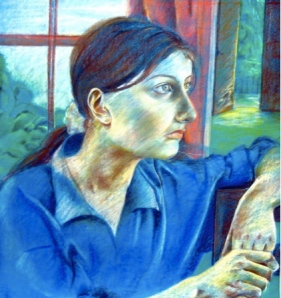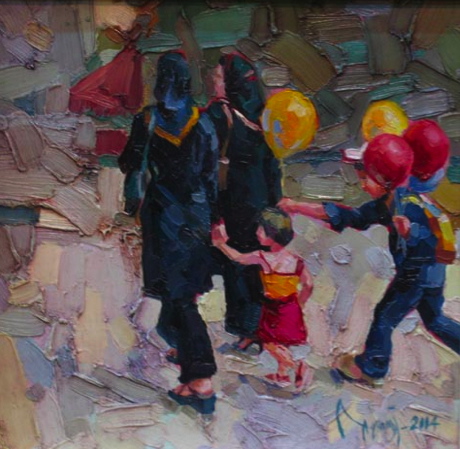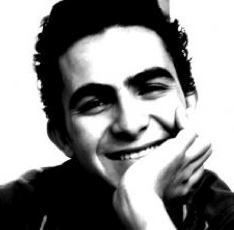
Beautiful painting by contemporary Iranian artist Parvaneh Ghasemi of a young Iranian woman.
Hi Everyone,
Late again! Walking out of a lecture this afternoon, two wonderful friends commented casually “don’t let being late put pressure on you!” I thought that was great advice, particularly if I want to keep these windows going. So, I am not going to apologize for being late this time. And, I have exciting news: yesterday we got featured on the front page of my university’s student publication Student Life, how cool is that? The article is called “Professor’s
writing aims to reshape view of American Muslims.” The paper found us on the web where a good friend Sheila Musaji posts these windows on her website The American Muslim. Thanks Sheila! Kind mentions of the write up in Student Life have been coming in.
Now without further ado, Window number 11 on Iran, on the eve of Halloween with trick-or-treaters in the background!
Current Issues
* The spooky subject of “nuclear threat” suits the Halloween
atmosphere. But before I get to Iran, you must listen to an
anecdote. I was sitting in our local Border’s bookstore with a cup
of coffee and twenty-five papers to read when my eyes caught the
cover of what I think was a September issue of the Newsweek. It
had a catchy title about the North Korean nuclear threat with a
grim picture of the country’s leader wearing a pair of dark
glasses, a mushroom cloud reflected in each. I should have known
better, but read the report which said more about the leader’s
inferiority complex and hair style than North Korea’s nuclear
technology. A few days later, a friend quoted his colleague (in
the hospital where he works) as saying he would shoot as many
North Koreans as necessary to rid the world of their threat. Only
then I realized that the North Korean leader’s menacing look —
and the official line that Koreans “pretend” to negotiate to buy
time — had worked on me too. The bigger shock came a week later,
reading a book that actually discussed North Korea’s breaking of
its promise and developing nuclear capability. The book attributed
it to the current U.S government’s breach of its earlier promises
to N. Korea, first by including Korea in the “axis of evil,” and
then terminating its pledged shipments of fuel oil and the agreed
construction of alternate power plants in that country. The writer
of the book was not Noam Chomsky but Jimmy Carter. Since I am
always going on about American media’s shortcomings, I should tell
you that the courage and forthrightness of this American brought
tears to my eyes. He wasn’t being partisan either. Here is what he
had to say about the real nuclear threat in our current world:
o “While claiming to be protecting the world from
proliferation threats in Iraq, Libya, Iran and North Korea,
American leaders have not only abandoned existing treaty
restrictions but also assert plans to test and develop new
weapons, including antiballistic missiles, the
earth-penetrating ‘bunker buster,’ and perhaps some secret
new ‘small bombs.’ They have also…reversed another long
standing policy, by threatening first use of nuclear weapons
against non nuclear states.” ( p.138 )
o And here is another quote from President Carter. If you want
to read more, I cite the reference below:
“The ABM Treaty prohibited space-based weapons, but our
government’s abandonment of the treaty in 2002 opened the
door on this extremely destabilizing project. The new
Defense Department doctrine defines our goals as “freedom to
attack as well as freedom from attack” in space. The goal is
to strike any target on earth within forty-five minutes. As
described by the U.S. Air Force, one method, named “Rods
from God,” would hurl cylinders of heavy metals to strike a
target at seventy-two hundred miles per hour, with the
destructive force of a small nuclear weapon.” (p.143)
Suggested Reading: Our Endangered Values: American’s Moral Crisis by
Jimmy Carter (New York: Simon & Schuster Paperbacks, 2005)
* Now, against this background, look at the Iranian situation
about which this week you have read alarming news of further steps
toward uranium enrichment. Look past headlines, mushroom clouds
reflected in sunglasses, and it turns out that Iranian plants —
even if they become fully operational — are currently configured
to produce low enriched uranium (LEU) rather than the
weapons-grade highly-enriched uranium (HEU). Even the CIA experts
put the chances of making the first bomb — if Iran decides to
make one — at 10 to 15 years ( here is the full essay although
the less alarming part comes close to the end):
http://news.bbc.co.uk/2/hi/middle_east/4606356.stm. In addition,
here (courtesy of my friend Seth Graebner) is a thoughtful and
fairly detailed analysis from the Foreign Affairs magazine on the
possibilities of negotiating with Iran concerning its nuclear
technology. It is by Scott Sagan professor of political science
at Stanford. Though the essay is a far cry form the alarmist
mushroom cloud images, it does call Iran the “rogue” regime,
“hostile,” etc. I suppose, that is the standard language these
days. One thing I really respected about President Carter’s book
was his dignified manner of speaking about other countries.
*I guess it is time to wrap up politics and attend to some more
interesting matters. Before that, however, I have had a request
from a very dear friend Cynthia Richards to distribute a
nonpartisan information sheet about the voting process in the
upcoming election, please click here to open it: Voting Information Sheet.
Cultural
* A hot cultural topic this week in the news concerns two legal
cases ruling the fate of a number of very important ancient
Persian artifacts held at US research universities. These legal
disputes, being heard at the United States District Court level,
revolve around 2,000-year-old Iranian items controlled by the
University of Chicago and Harvard University. If these cases
produce conflicting judgments, they may be taken up at the Supreme
Court, meaning there won’t be swift resolutions. In the meantime,
more Iranian artifacts are likely to be targeted. To read more,
click on: http://www.niacouncil.org/pressreleases/press476.asp.
* On October 18, The Iranian Cultural Heritage Organization declared
the house of the prominent woman poet Parvin Etesami (1906-1941)
to be named a national monument.
http://en.wikipedia.org/wiki/Parvin_Etesami. A charming house of
over 1,000 square meters, located in the neighborhood of
Sarcheshmeh on the outskirts of Tehran, Etesami’s house is nearly
a century old. Etesami who has been somewhat overshadowed by the
powerful later female poetic voices of 20th cent. Iran, has had a
gentle, yet firm and lasting presence. Her poetic themes range
from celebration of motherhood and descriptions of nature, to
strong advocacy for social and political reform. You can find a
good deal of Etesami’s poems, in the original Persian, on the web
at: http://www.anvari.org/iran/Poetry/Parvin_Etesami/ though I
have to confess to ignorance about the quality of the edition. For
a more reliable source, see the reading below.
Suggested reading: Once a Dew drop: Essays on the Poetry of Parvin
Etesami. Edited by Heshmant Moayyad as well as A Nightingale’s Lament:
Selections from the Poems and Fables of Parvin Etesami also by Heshmat
Moayyad are both available from Amazon Books.
Visual Delight
* To honor the trick-or-treat tradition, I have a special treat
this week. My friend Bahar Bastani sent four paintings by a
contemporary Iranian painter Iman Maleki that were just exquisite
images of young women, oil on canvas. Not only was the quality of
Maleki’s paintings almost breathtaking, I was astounded at the
fact that I had never heard of him. And I consider myself
interested in the art of painting, not to mention annual visits to
Iran. So, I put together a small slide show for you of a handful
of contemporary Iranian painters working with human figure in
their work. I call it “portraits” but they are not all portraits.
I provide the artists’ name but don’t always have their pictures
or other details. All the painters currently live in Iran. As
usual, click here to view the slideshow: Iranian Contemporary Painting “Portraits”. Enjoy!
Have a great week!
Fatemeh
========================
Fatemeh Keshavarz, Professor and Chair
Dept. of Asian and Near Eastern Languages and Literatuares
Washington University in St. Louis
Tel: (314) 935-5156
Fax: (314) 935-4399
========================
Read Full Post »












